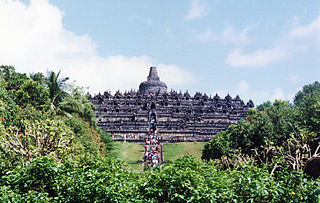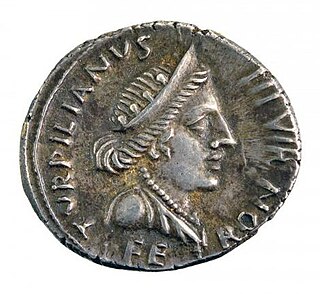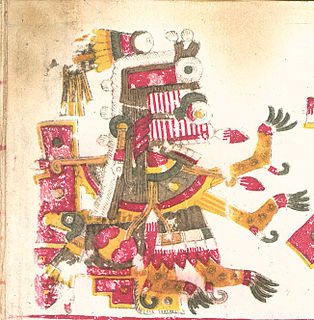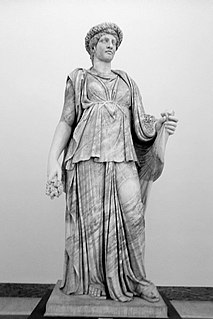 W
WAcca Larentia or Acca Larentina was a mythical woman, later goddess of fertility, in Roman mythology whose festival, the Larentalia, was celebrated on December 23.
 W
WIn ancient Roman religion, Annona is the divine personification of the grain supply to the city of Rome. She is closely connected to the goddess Ceres, with whom she is often depicted in art.
 W
WAphaea was a Greek goddess who was worshipped almost exclusively at a single sanctuary on the island of Aegina in the Saronic Gulf. She originated as early as the 14th century BCE as a local deity associated with fertility and the agricultural cycle. Under the later Athenian hegemony she came to be identified with the goddesses Athena and Artemis and with the nymph Britomartis as well, by the 2nd century CE, the time of Pausanias: On Aigina as one goes toward the mountain of Zeus, god of all the Hellenes, the sanctuary of Aphaia comes up, for whom Pindar composed an ode at the behest of the Aeginetans. The Cretans say that Euboulos was the son of Kharmanor, who purified Apollo of the killing of the Python, and they say that Britomartis was the daughter of Zeus and Kharme. She enjoyed races and hunts and was particularly dear to Artemis. While fleeing from Minos, who lusted after her, she cast herself into nets cast for a catch of fish. Artemis made her a goddess, and not only the Cretans but also the Aeginetans revere her. The Aeginetans say that Britomartis showed herself to them on their island. Her epithet among the Aeginetans is Aphaia, and it is Diktynna of the Nets on Crete. Description of Greece 2.30.3
 W
WAshnan, also known as Ezina or Ezina-Kusu, was the goddess of grain in Mesopotamia. She and her brother Lahar, both children of Enlil, were created by the gods to provide the Annunaki with food, but when the heavenly creatures were found unable to make use of their products, humankind was created to provide an outlet for their services.
 W
WAthena or Athene, often given the epithet Pallas, is an ancient Greek goddess associated with wisdom, handicraft, and warfare who was later syncretized with the Roman goddess Minerva. Athena was regarded as the patron and protectress of various cities across Greece, particularly the city of Athens, from which she most likely received her name. The Parthenon on the Acropolis of Athens is dedicated to her. Her major symbols include owls, olive trees, snakes, and the Gorgoneion. In art, she is generally depicted wearing a helmet and holding a spear.
 W
WIn ancient Roman religion, Ceres was a goddess of agriculture, grain crops, fertility and motherly relationships. She was originally the central deity in Rome's so-called plebeian or Aventine Triad, then was paired with her daughter Proserpina in what Romans described as "the Greek rites of Ceres". Her seven-day April festival of Cerealia included the popular Ludi Ceriales. She was also honoured in the May lustratio of the fields at the Ambarvalia festival, at harvest-time, and during Roman marriages and funeral rites.
 W
WIn Aztec mythology, Chicomecōātl [t͡ʃikomeˈkoːaːt͡ɬ] "Seven Serpent", was the Aztec goddess of agriculture during the Middle Culture period. She is sometimes called "goddess of nourishment", a goddess of plenty and the female aspect of maize.
 W
WDea Dia was a goddess of fertility and growth in ancient Roman religion. She was sometimes identified with Ceres, and sometimes with her Greek equivalent Demeter.
 W
WIn ancient Greek religion and mythology, Demeter is the Olympian goddess of the harvest and agriculture, presiding over grains and the fertility of the earth. She was also called Deo (Δηώ).. Her cult titles include Sito (Σιτώ), "she of the Grain", as the giver of food or grain, and Thesmophoros, "giver of customs" and/or "legislator", in association with the secret female-only festival called the Thesmophoria.
 W
WDewi Sri or Shridevi, Dewi Sri) is the Javanese, Sundanese, and Balinese pre-Hindu and pre-Islamic Goddess of rice and fertility, still widely worshiped on the islands of Java, Bali and Lombok, Indonesia.
 W
WIn ancient Roman religion, Feronia was a goddess associated with wildlife, fertility, health, and abundance. As the goddess who granted freedom to slaves or civil rights to the most humble part of society, she was especially honored among plebeians and freedmen. Her festival, the Feroniae, was November 13 during the Ludi Plebeii, in conjunction with Fortuna Primigenia; both were goddesses of Praeneste.Note that the similar-sounding Feralia on February 21 is a festival of Jupiter Feretrius, not Feronia.
 W
WIn Norse mythology, Gefjon is a goddess associated with ploughing, the Danish island of Zealand, the legendary Swedish king Gylfi, the legendary Danish king Skjöldr, foreknowledge, and virginity. Gefjon is attested in the Poetic Edda, compiled in the 13th century from earlier traditional sources; the Prose Edda and Heimskringla, written in the 13th century by Snorri Sturluson; in the works of skalds; and appears as a gloss for various Greco-Roman goddesses in some Old Norse translations of Latin works.
 W
WGeshtinanna is the ancient Sumerian goddess of agriculture, fertility, and dream interpretation, the so-called "heavenly grape-vine". She is the sister of Dumuzid and consort of Ningisida. She is also the daughter of Enki and Ninhursag. She shelters her brother when he is being pursued by galla demons and mourns his death after the demons drag him to Kur. She eventually agrees to take his place in Kur for half the year, allowing him to return to Heaven to be with Inanna. The Sumerians believed that, while Geshtinanna was in Heaven and Dumuzid in Kur, the earth became dry and barren, thus causing the season of summer.
 W
WHeqet, sometimes spelled Heket, is an Egyptian goddess of fertility, identified with Hathor, represented in the form of a frog. To the Egyptians, the frog was an ancient symbol of fertility, related to the annual flooding of the Nile. Heqet was originally the female counterpart of Khnum, or the wife of Khnum by whom she became the mother of Her-ur. It has been proposed that her name is the origin of the name of Hecate, the Greek goddess of witchcraft.
 W
WIn Greek mythology the Horae or Horai or Hours were the goddesses of the seasons and the natural portions of time.
 W
WIn Aztec religion, Ītzpāpālōtl [iːt͡spaːˈpaːlot͡ɬ] was a striking skeletal warrior goddess who ruled over the paradise world of Tamoanchan, the paradise of victims of infant mortality and the place identified as where humans were created. She is the mother of Mixcoatl and is particularly associated with the moth Rothschildia orizaba from the family Saturniidae. Some of her associations are birds and fire. However, she primarily appears in the form of the Obsidian Butterfly.
 W
WThe Matres and Matronae were female deities venerated in Northwestern Europe, of whom relics are found dating from the first to the fifth century AD. They are depicted on votive offerings and altars that bear images of goddesses, depicted almost entirely in groups of three, that feature inscriptions and were venerated in regions of Germania, Eastern Gaul, and Northern Italy that were occupied by the Roman army from the first to the fifth century.
 W
WMayahuel is the female deity associated with the maguey plant among cultures of central Mexico in the Postclassic era of pre-Columbian Mesoamerican chronology, and in particular of the Aztec cultures. As the personification of the maguey plant, Mayahuel is also part of a complex of interrelated maternal and fertility goddesses in Aztec religion and is also connected with notions of fecundity and nourishment.
 W
WMarzanna, Marena, Mara, Morana, Morena or Mora is a pagan Slavic goddess associated with seasonal rites based on the idea of death and rebirth of nature. She is an ancient goddess associated with winter's death, rebirth and dreams. In ancient Slavic rites, the death of the Goddess Marzanna at the end of winter becomes the rebirth of Spring of the Goddess Kostroma (Russian), Lada or Vesna representing the coming of Spring.
 W
WNisaba, is the Sumerian goddess of writing, learning, and the harvest. She was worshiped in shrines and sanctuaries at Umma and Ereš, and was often praised by Sumerian scribes. She is considered the patroness of mortal scribes as well as the scribe of the gods. In the Babylonian period, her worship was mainly redirected towards the god Nabu, who took over her functions.
 W
WPachamama is a goddess revered by the indigenous peoples of the Andes. In Inca mythology she is an "Earth Mother" type goddess, and a fertility goddess who presides over planting and harvesting, embodies the mountains, and causes earthquakes. She is also an ever-present and independent deity who has her own creative power to sustain life on this earth. Her shrines are hallowed rocks, or the boles of legendary trees, and artists envision her as an adult female bearing harvests of potatoes and coca leaves. The four cosmological Quechua principles – Water, Earth, Sun, and Moon – claim Pachamama as their prime origin. Priests sacrifice offerings of llamas, cuy, children and elaborate, miniature, burned garments to her. Pachamama is the mother of Inti the sun god and Mama Killa the moon goddess. Pachamama is said also be the wife of Inti, her son.
 W
WPhosop or Phaisop is the rice goddess of the Thai people. She is a deity more related to ancient Thai folklore than a goddess of a structured, mainstream religion. She is also known as Mae Khwan Khao.
 W
WPomona was a goddess of fruitful abundance in ancient Roman religion and myth. Her name comes from the Latin word pomum, "fruit", specifically orchard fruit.
 W
WProserpina or Proserpine is an ancient Roman goddess whose cult, myths and mysteries were combined from those of Libera, an early Roman goddess of wine. In Greek she is known as Persephone and her mother is Demeter, goddesses of grain and agriculture. The originally Roman goddess Libera was daughter of the agricultural goddess Ceres and wife to Liber, god of wine and freedom. In 204 BCE, a new "Greek-style" cult to Ceres and Proserpina as "Mother and Maiden" was imported from southern Italy, along with Greek priestesses to serve it, and was installed in Libera and Ceres' temple on Rome's Aventine Hill. The new cult and its priesthood were actively promoted by Rome's religious authorities as morally desirable for respectable Roman women, and may have partly subsumed the temple's older, native cult to Ceres, Liber and Libera; but the new rites seem to have functioned alongside the old, rather than replaced them.
 W
WRenenūtet was a goddess of nourishment and the harvest in ancient Egyptian religion. The importance of the harvest caused people to make many offerings to Renenutet during harvest time. Initially, her cult was centered in Terenuthis. Renenutet was depicted as a cobra, or as a woman with the head of a cobra.
 W
WIn ancient Roman religion, agricultural deities were thought to care for every aspect of growing, harvesting, and storing crops. Preeminent among these are such major deities as Ceres and Saturn, but a large number of the many Roman deities known by name either supported farming or were devoted solely to a specific agricultural function.
 W
WIn Ancient Egyptian religion, Taweret is the protective ancient Egyptian goddess of childbirth and fertility. The name "Taweret" (Tȝ-wrt) means "she who is great" or simply "great one", a common pacificatory address to dangerous deities. The deity is typically depicted as a bipedal female hippopotamus with feline attributes, pendulous female human breasts, the limbs and paws of a lion, and the back and tail of a Nile crocodile. She commonly bears the epithets "Lady of Heaven", "Mistress of the Horizon", "She Who Removes Water", "Mistress of Pure Water", and "Lady of the Birth House".
 W
WIn ancient Roman religion and myth, Tellus Mater or Terra Mater is a goddess of the earth. Although Tellus and Terra are hardly distinguishable during the Imperial era, Tellus was the name of the original earth goddess in the religious practices of the Republic or earlier. The scholar Varro (1st century BC) lists Tellus as one of the di selecti, the twenty principal gods of Rome, and one of the twelve agricultural deities. She is regularly associated with Ceres in rituals pertaining to the earth and agricultural fertility.
 W
WToyouke-Ōmikami is the goddess of agriculture and industry in the Shinto religion. Originally enshrined in the Tanba region of Japan, she was called to reside at Gekū, Ise Shrine, about 1,500 years ago at the age of Emperor Yūryaku to offer sacred food to Amaterasu Ōmikami, the Sun Goddess.
 W
WVacuna was an ancient Sabine goddess, identified by ancient Roman sources and later scholars with numerous other goddesses, including Ceres, Diana, Nike, Minerva, Bellona, Venus and Victoria. She was mainly worshipped at a sanctuary near Horace's villa, in sacred woods at Reate, and at Rome.
 W
WIn ancient Roman religion, agricultural deities were thought to care for every aspect of growing, harvesting, and storing crops. Preeminent among these are such major deities as Ceres and Saturn, but a large number of the many Roman deities known by name either supported farming or were devoted solely to a specific agricultural function.
 W
WŽemyna is the goddess of the earth in Lithuanian religion. She is usually regarded as mother goddess and one of the chief Lithuanian gods similar to Latvian Zemes māte. Žemyna personifies the fertile earth and nourishes all life on earth, human, plant, and animal. All that is born of earth will return to earth, thus her cult is also related to death. As the cult diminished after baptism of Lithuania, Žemyna's image and functions became influenced by the cult of Virgin Mary.